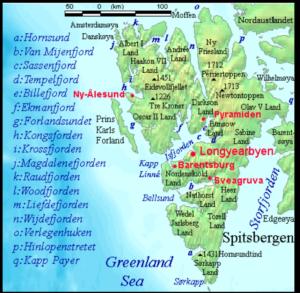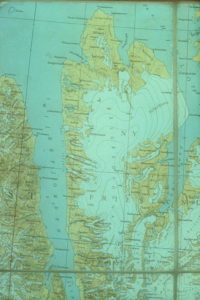Spitsbergen (Svalbard)
After climbing in equatorial Africa, the Arctic was the most predictable direction for our next mountaineering expedition. We found a few unclimbed summits in Atomfiella (Atomic) Mountains in Spitsbergen, a half-way from Norway to the North Pole. Mountains are “Atomic” because their summits carry names of nuclear physicists: Bohr, Thompson, Curie, Rutheford…

In 1977, the Mountaineering Clubs of Gliwice and Poznań, Poland, arranged an expedition of 11 climbers and scientists, composed of J. Chalecki, L. Czarnecki, M. Bernadt, H. Dastych (biology), P. Kłysz (geomorphology), M. Kuraś, K. Rękosiewicz, T. Szulc, A. Szyszko (physician), T. Schramm, with Ryszard W. Schramm, a professor of biochemistry, as the Expedition Leader. Climbing still untouched by people Attomfiella summits and carry on biological and geomorphological research in the Arctic were the Expedition goals. We were to stay in Spitsbergen for six weeks of the arctic summer.
In the summer time the sea around Spitsbergen is not frozen, so that we sent our equipment by sea to a Russian settlement, Barenstsburg, which operates a coal mine there, while we went by air to Longyerbean, where the Norwegian govern-ment of the island was located.
Taken by a Russian helicopter to tundra, we packed the equipment, fuel, and food for six weeks in the uninhabited country, to sledges that were also to serve as boats for crossing glacier rivers. With sledges loaded to 150 kg, we started to pull up, on the country skis, to the continental glacier, Asgardfonna, which fills the interior of the North Spitsbergen at the level of 1000m. In a dense fog, with the visibility confined to a couple of meters, with the magnetic declination of Magnetic Pole from the geographic one in the range of 90 degrees, which made the compass almost useless, keeping direction for a narrow Aries Pass, the entrance to Asgardfonna, was the main issue. Pulling so heavy sledges up the glacier for several hours a day was so hard that some of us had blood on lips.
After three days of this hardship, the fog has gone, we found the Aries Pass and entered the Asgardfonna, flat, and in incredibly beautiful arctic weather. The air was so dry and clear that we were able to see rocks at a distance of 150 km. So, we are in Atomfiella Mountains, with several summits waiting for climbing.

With Tadek Szulc we climb a summit built of semi-transparent greenish quartz. Very close was the Mt. Curie summit. After the expedition, we suggest to the Norwegian authorities to name the summit we climbed and which was never climbed before, as “Mt. Curie-Skłodowska” summit, after a Polish woman physicist, who received twice the Nobel Prize for the discovery of two radioactive elementary particles, the rad, and the polon. Unfortunately, it did not happen. Only a small container with the date when it was climbed and our names had left on the summit. The same was with other summits we climbed in Atomfiella.
After two weeks of climbing activity, the Expedition Leader, R.W. Shramm told: fifty years ago, in 1937, three Polish explorers crossed, as the first people, the Spitsbergen on skies. Maybe, we repeat the northern part of their traverse? It was a challenge. Almost extra 300 km. Also, we went to Atomfiella on the conditions of XIX century explorers: without radio communication equipment. We were not able to broadcast SOS signals and ask for rescue. Janusz Chalecki, Leszek Czarnecki, Mirek Kuraś and Shramm son, Tomasz, decide to go, however, to reach the very north tip of Spitsbergen – Verlegenhooken.

It was late summer. Asgardfonna glacier melted and it was covered with random rivers, some deeply in the glacier, some shallow on its surface. It was not easy to find a route. Our sledges with closed bottoms helped us to cross smaller of them, larger has to be by-passed. Days were difficult to count because there were no nights. When we concluded that we are approaching the end of the glacier, and we will go down to tundra, we left sledges and took only skies. In a couple of days, we reached the northern tip of Spitsbergen. The return was a bit dramatic, however. The northern slopes of Asgardfonna have turned into hundred streams that cut us from sledges with the food for 200 km long return trip. Moreover, how to find them on a huge flat glacier of several square kilometers area without any terrestial marks. Fortunately, we found these sledges.
The whole traverse, almost 500 km long, took 23 days, but we avoided the greatest danger of this expedition: the polar bears. It was not allowed to have any rifle for a protection. Spitsbergen had at that time status of a National Park, so that protected were polar bears rather than people. A bear which would have spotted us could have a fresh breakfast each morning. We learned the last day of the Expedition, that when we were at the East Spitsbergen, a member of an Austrian Expedition to the West Spitsbergen was killed and eaten by a bear.
…………………………………………………………………………………………………………………………………………………………………………………………………………………………………………………….

































































